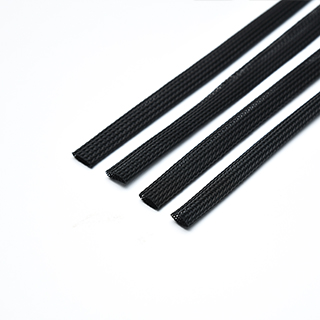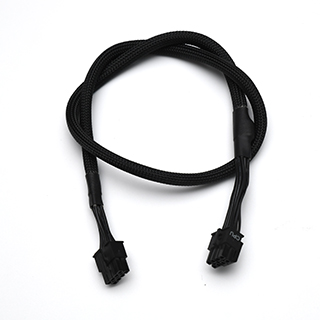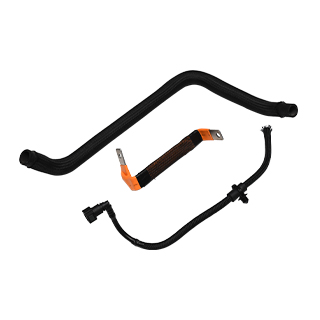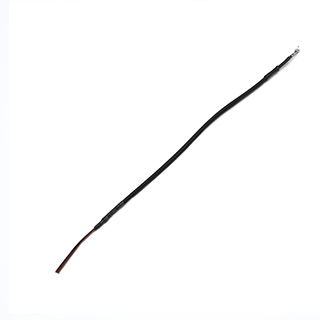





PET Expandable Braided Sleeving
PET Expandable Braided Sleeving, also known as expandable braided sleeving, is a lightweight, flexible protective sleeve made from high-quality polyester (Polyethylene Terephthalate, PET) monofilaments. Its unique braided structure allows up to 50% radial expansion while maintaining longitudinal stability, making it ideal for bundling and protecting cables, wires, hoses, and delicate components.
This engineering thermoplastic material has a melting point of 250–260°C and a continuous service temperature range of -40°C to +150°C, offering superior thermal, chemical, and mechanical performance across a wide range of industrial applications.

Key Technical Characteristics
Expandable Design: Radial expansion up to 50% accommodates varying bundle sizes while maintaining a tight, secure fit.
Flame Resistance: Meets UL 94 V-2 standards with self-extinguishing time <30s and flame spread <75mm.
Mechanical Strength: Tensile strength ≥200 N/cm and elongation at break ≥50%.
Chemical Resistance: Resistant to most acids, alkalis, solvents, and common automotive fluids (<1% weight change after 24h immersion).
Dielectric Properties: Surface resistance >10¹² Ω, dielectric strength >20 kV/mm for electrical insulation.
Flexibility: Endures over 1,000,000 flex cycles at a 90° bend radius without failure.
EMI Shielding (Metallized Versions): Attenuation of 30–60 dB from 10 MHz to 1 GHz.
Lightweight: 40% lighter than PVC sleeves while offering 300% greater abrasion resistance.
Heat Dissipation: Open mesh structure provides 20–30% better heat dissipation compared to solid-wall conduits.
Manufacturing Specifications
The manufacturing process involves precision braiding with 16-48 carriers depending on sleeve diameter, producing a mesh density of 60-85% coverage. Standard diameters range from 3mm to 150mm with wall thicknesses between 0.3mm to 1.2mm. The braiding angle is maintained at 45±5° for optimal expansion and flexibility balance.
Superior Protection: Shields wires, cables, hoses, and sensitive components from abrasion, UV exposure, chemical corrosion, and mechanical stress.
Ease of Installation: Expandable sleeve design allows rapid deployment over bundles of varying diameters.
Durability: Long service life exceeding 10 years under typical industrial conditions.
Environmental Sustainability: Made from 100% recyclable PET with >85% recovery rate; lower CO2 emissions than PVC alternatives.
Weight Savings: Particularly beneficial in automotive and aerospace applications for reducing system weight without compromising protection.
Automotive Industry: Wire harness protection in engine compartments; resistant to ATF, brake fluid, and engine oils; SAE J2031 compliant.
Aerospace Applications: Lightweight cable protection in avionics bays; metallized versions provide EMI shielding; AS6070 compliant.
Industrial Machinery: Protects hydraulic and pneumatic lines from mechanical abrasion; suitable for cleanroom environments.
Renewable Energy: UV-resistant for solar installations (>3000h per IEC 61340); salt spray resistant for wind turbines (1000h per ISO 9227).
Consumer Electronics: Strain relief for USB, HDMI, and other consumer cables; durable through >10,000 bend cycles; available in RAL color standards for design integration.
Installation Notes
Select sleeve diameter 1.5× the bundle diameter for easy installation.
Cut sleeve using a 3:1 length ratio to accommodate expansion.
Install at temperatures >10°C to prevent material brittleness.
Secure sleeve ends with heat-shrink tubing or clips rated for application temperatures.
Maintain a minimum bend radius of 4× sleeve diameter during routing.
Maintenance and care
Cleaning: Mild detergent (pH 6–8) with soft brush; rinse with deionized water <60°C; compressed air drying <3 bar.
Chemical Cleaning: Isopropyl alcohol (70%) for oil; 5% citric acid for alkaline deposits; always perform compatibility testing.
Inspection: Quarterly checks for abrasion >50% wall thickness, UV degradation (∆E >3), loss of flexibility (>20%), mesh deformation >15%.
Replacement Criteria: Filament breaks >5 per 10cm, radial expansion <30% of original diameter, surface resistance <10¹⁰ Ω in critical applications.
Q1: What is the difference between PET expandable braided sleeving and regular sleeving?
A1: PET expandable braided sleeving is lightweight, highly flexible, and chemically resistant, with radial expansion up to 50%. Unlike standard PVC or textile sleeves, it offers superior abrasion resistance, heat dissipation, and long-term durability.
Q2: How do I choose the right size expandable sleeve?
A2: Select a sleeve with a diameter 1.5× the bundle diameter to allow easy installation and proper expansion.
Q3: Can expandable braided sleeving be used in high-temperature applications?
A3: Yes, PET expandable sleeving can withstand continuous temperatures up to +150°C and short peaks up to 260°C.
Q4: Is metallized PET expandable braided sleeving suitable for EMI shielding?
A4: Yes, metallized versions provide 30–60 dB attenuation from 10 MHz to 1 GHz, suitable for sensitive electronic and aerospace applications.
Q5: Is PET expandable braided sleeving environmentally friendly?
A5: Absolutely, it is 100% recyclable with high recovery rates and lower CO2 emissions compared to PVC alternatives.